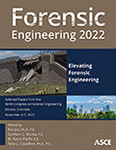Comparison of In Situ Field Test and Laboratory Test Results for Assessment of Static and Seismic Liquefaction Susceptibility of a Tailings Dam
Publication: Forensic Engineering 2022
ABSTRACT
A tailings dam is typically an earth-fill containing embankment/facility used to store the materials left over after the process of separating the valuable fraction from the uneconomic fraction of an ore. In designing a tailings dam, Cone Penetration Tests (CPTs) are being increasingly used to assess soil behaviour and the potential/susceptibility of the material to liquefaction. This paper presents CPT data interpreted by two Geologismiki software packages (CPeT-IT and CLiq) compared with interpreted laboratory test results from intact samples at specific depths and locations from a gold mining operation. Results from Consolidated Anisotropic Undrained (CAU) triaxial tests, Consolidated Isotropic Undrained (CIU) triaxial tests, and Cyclic Simple Shear (CSS) tests were compared with CPT interpreted results in terms of static and seismic liquefaction potential and soil behaviours. The results showed that the CPT interpreted results were around 10% higher than laboratory test results and were more conservative. However, the soil behaviour as defined by the compared methods was similar. This paper provides recommendations for suitable testing for designers to use in assessing liquefaction potential.
Get full access to this article
View all available purchase options and get full access to this chapter.
REFERENCES
ANCOLD (Australian National Committee on Large Dams). (2019). Guideline on Tailings Dam, Planning, Design, Construction, Operation, and Closure. Hobart, Australia. https://www.ancold.org.au.
ANCOLD (Australian National Committee on Large Dams). (2012). Guidelines on the Consequence Categories for Dams. Hobart, Australia. https://www.ancold.org.au.
Bedell, P., Sanin, M., and Hiemstra, C. (2020). “Stability Assessment of a Tailings Dam with Frozen Tailings.” Proc. 24th Int. Conf. on Tailings and Mine Waste, Alberta, Canada, 319–326.
CLiq Software (v. 3.0.2.4). (2021). “GEOLOGISMIKI – CLiq,”. https://geologismiki.gr/products/cliq/.
CPet-IT Software (v. 3.0.3.2). (2021). “GEOLOGISMIKI – CPeT”. http://www.geologismiki.gr/Documents/CPeT-IT/HTML/index.html.
DeJong, J. T., and Green, K. C. (2020). “Variable Penetration Rate CPT Testing for Mine Tailings Characterization.” Proc. 24th Int. Conf. on Tailings and Mine Waste, Alberta, Canada, 679–695.
Engstrom, K., Toyrii, S., Danilov, S., and Knutsson, R. (2020). “Variability in Sand Characteristics - A Case Study at LKAB Mine Tailings Facility in Sweden.” Proc. 24th Int. Conf. on Tailings and Mine Waste, Alberta, Canada, 307–319.
Idriss, I. M., and Boulanger, R. W. (2008). Soil Liquefaction During Earthquakes, Earthquake Eng. Research Ins., US.
Jefferies, M., and Been, K. (2016). Soil Liquefaction: A Critical State Approach., 2nd Edition. CRC Press.
Jeyapalan, J. K., Duncan, J. M., and Seed, H. B. (1983). “Analyses of Flow Failures of Mine Tailings Dams.” ASCE, J. of Geotec. Eng., 109(2), 150–171.
Kramer, S. L, and Wang, C. (2015). “Empirical model for estimation of the residual strength of liquefied soil.” J. of Geotec. and Geoenv. Eng., ASCE, 141(9), 140–153.
Lunne, T., Powell, J. J., and Robertson, P. K. (1997). Cone Penetration Testing in Geotechnical Practice. CRC Press.
Macedo, J., Bray, J., Oslan, S., Bareither, C., and Arnold, C. (2020). “Tailing Mine Tailings Database”, Proc. 24th Int. Conf. on Tailings and Mine Waste, Alberta, Canada, 319–326.
Oliveira, J. R., Almeida, M. S., Motta, H. P., and Almeida, M. C. (2011). “Influence of penetration rate on penetrometer resistance.” J. of Geotec. and Geoenv. Eng., 137(7), 695–703.
Olson, S. M., and Stark, T. D. (2002). “Liquefied Strength Ratio From Liquefaction Flow Failure Case Histories.” Canadian Geotec. J., 39(3), 629–647.
Robertson, P. K. (2009). “Interpretation of Cone Penetrometer Tests – a unified approach.” Canadian Geotec. J., 46 (11), 1337–1355.
Rico, M., Benito, G., and Diez-Herrero, A. (2008). “Floods from Tailings Dam Failures.” J. of Hazardous Materials, 154(1-3), 79–87.
Santamarina, J. C., Luis, A. T., and Robert, C. B. (2019). “Why Coal Ash and Tailings Dam Disasters Occur.” Sci., 364(6440), 526–528.
Sarsby, R. W. (2000). Environmental Geotechnics. Thomas Telford.
Stark, T. D., and Mesri, G. (1992). “Undrained Shear Strength of Liquefied Sands for Stability Analysis.” J. of Geotec. Eng., ASCE, 118(11),1727–1747.
Information & Authors
Information
Published In
History
Published online: Nov 2, 2022
Authors
Metrics & Citations
Metrics
Citations
Download citation
If you have the appropriate software installed, you can download article citation data to the citation manager of your choice. Simply select your manager software from the list below and click Download.
